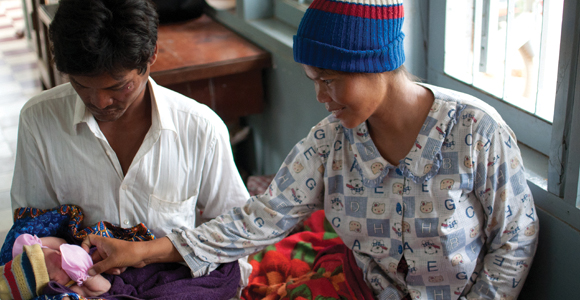The maternal mortality ratio in Cambodia has dramatically decreased from 472 per 100,000 live births in 2005 to 206 per 100,000 live births in 2010, then to 170 per 100,000 live births in 2014 (CDHS 2014) and to 154 per 100,000 live births in 2021 (CDHS 2021-2022). The Royal Government of Cambodia's SDG target 2030 is 70 per 100,000 live births.
The average age at first birth for women aged 25-49 is 23.3 years. However, early childbearing is still an issue, as teenage pregnancy is 9% among women aged 15-19. The data showed that 59% of married women aged 15-19 did not use contraceptive methods in (CDHS 2021). There was an uptake of contraceptive use as the unmet need for family planning gradually dropped from 12.5% in 2014 to 11.5% in 2021, where 62% of married women used any method of family planning, and 45% used any modern method.
The total fertility rate fell from 3.8 births per woman in 2000 to 2.7 births per woman in 2014 and remained the same in 2021-2022. Rural (3.0) fertility is higher than urban areas (2.4). There was an inverse relationship between fertility rate and family wealth, with 3.5 per woman in the poorest households and 2.2 children per woman in wealthy families.
RACHA programs, which focus on improving reproductive, maternal, newborn, and child health, have played a significant role in this progress as they worked to strengthen both the demand and supply sides of health care and commune administration.
In its previous projects, RACHA supported the strengthening of pre-service and in-service training of midwives and worked to advance the skills and knowledge of midwives by providing training and maintaining up-to-date knowledge and practical skills throughout the year. Additionally, Maternal and Newborn Health programs also supported structural upgrades of health facilities to comply with Emergency Obstetric and Newborn Care (EmONC) standards, including the construction of waiting rooms; installing solar systems, and water filtration systems and providing medical equipment and materials to improve the quality of maternal and newborn care at health centers (HC).
It utilized the informal network at the grassroots to promote positive behavior change and communication among families. It vigorously encouraged women to deliver at health facilities and access antenatal care (ANC) and post-natal care (PNC). It strengthened the Village Emergency Referral System (VERS) in remote communities to transport emergency cases to health facilities and ensure women with complications can receive life-saving emergency treatment in time. As a complement to VERS, it initiated Charity Boxes to be set up in the Pagodas to generate funds for emergency transportation, especially among poor women.
RACHA has included gender in its cross-cutting themes. Although women are mostly the target of RACHA's projects, it also promotes male involvement to widen participation and commitment from the community. It ensures that both males and females have equal access to health messages and other project services. It disaggregates the data collected by gender to monitor the number of men and women served. RACHA's workforce is also composed of 62% females.

 : +855 23 213 724 | +855 23 726 257
: +855 23 213 724 | +855 23 726 257 : office@racha.org.kh
: office@racha.org.kh













